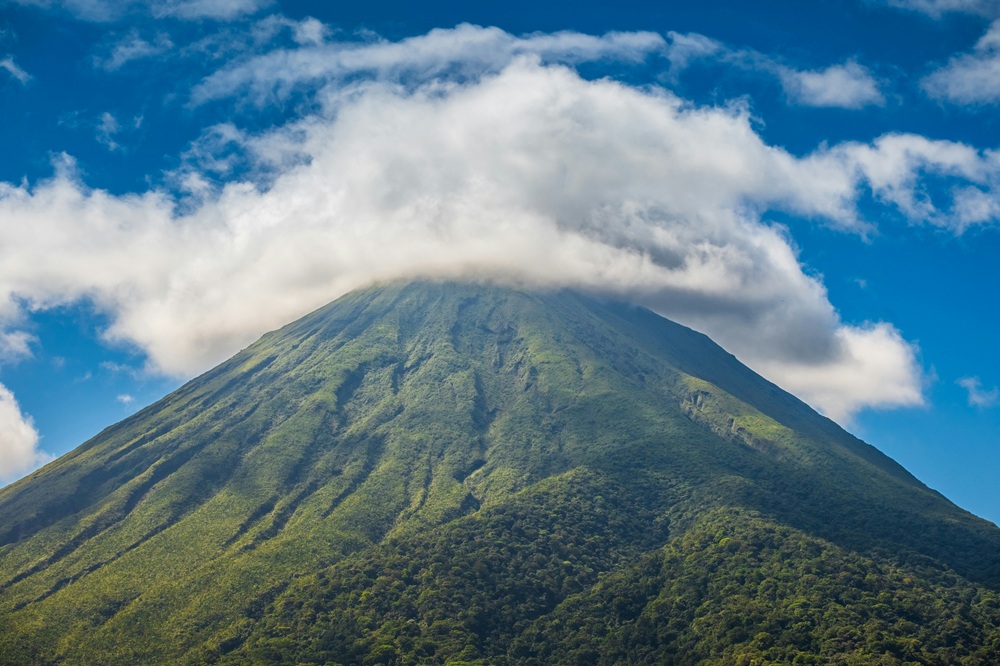Arenal Volcano
Arenal rises like a perfect cone over the lush lowlands of La Fortuna, Costa Rica’s adventure capital. Even on misty days, its silhouette anchors a landscape of rainforest trails, hanging bridges, thundering waterfalls, and naturally heated hot springs fed by the volcano’s geothermal heart.
Why Go
- Iconic cone volcano: Photogenic from almost every angle—with lava fields and regenerating forest on its flanks.
- Hot springs: A spectrum from quiet, mineral-rich rivers to full-service spa resorts.
- All-in-one adventure hub: Ziplining, canyoning, rafting, hanging bridges, wildlife night walks—easy to stack in 1–3 days.
Top Things to Do
- Arenal Volcano National Park: Walk lava flow trails (e.g., 1968 lava fields) and lookouts across savanna and secondary forest.
- Místico Hanging Bridges: Canopy views with frequent toucan, motmot, and monkey sightings.
- La Fortuna Waterfall: A steep stairway to a jungle pool beneath a 70-meter cascade—bring water shoes.
- Hot Springs Circuit: From rivers like Río Chollín (rustic) to resorts with multiple thermal pools and waterfalls.
Lake Arenal
Lake Arenal is Costa Rica’s largest lake—a scenic reservoir that wraps around the volcano’s western and southern flanks. It’s a playground for wind sports, quiet paddles, birds, and sunset drives.
- Sunset & viewpoints: The dam road and pullouts along Route 142 deliver mirror-like reflections and pink-gold skies when conditions are calm.
- Wind & water sports: Consistent winds near Tilarán make seasonal windsurfing and kitesurfing a draw; elsewhere, go kayaking or SUP on protected coves.
- Boat taxi to Monteverde: The classic jeep–boat–jeep route crosses the lake, then continues by road into the cloud forest—fast and scenic vs. the full road loop.
- Wildlife & birding: Watch for herons, kingfishers, hawks, and occasional toucans along forested shorelines; early morning is best.
- Fishing: Local charters target guapote (rainbow bass) and tilapia—ask about catch-and-release practices.
Wildlife & Nature
Lowland rainforest supports howler and white-faced capuchin monkeys, sloths, coatis, toucan species, and vibrant frogs and lizards. Early morning or guided night walks maximize sightings.
When to Visit
Dry season (Dec–Apr) offers more volcano views and easier trail conditions. Green season (May–Nov) means lusher foliage, dramatic clouds, and afternoon showers—plan hikes for the morning, lake/springs later.
Safety & Access
- Restricted summit: Climbing the cone is prohibited for safety; stick to signed trails and viewpoints.
- Weather swings: Carry rain layers; trails and docks can be slick. Obey closures during storms or seismic advisories.
- Lake conditions: Afternoon winds can raise chop—choose sheltered coves for SUP and confirm boat departures on blustery days.
- Hot springs etiquette: Hydrate, limit alcohol, and shower before entering pools.
What to Bring
- Closed-toe shoes with grip for lava rock and wet boardwalks.
- Light rain jacket and quick-dry layers.
- Swimwear, towel, and a dry bag for lake days and hot springs.
- Insect repellent and reef-safe sunscreen.
- Binoculars/zoom lens for birds and distant wildlife.
Photography Tips
- Early starts: The volcano is most visible around sunrise before clouds build; the lake is glassier in the morning.
- Layered compositions: Frame Arenal with foreground lava rocks, lake piers, or roadside pasture.
- Mood shots: Mist, backlit drizzle, and wind streaks on the lake add drama—protect gear and embrace it.
Hike lava flows by morning, cross Lake Arenal by boat at midday, and soak in hot springs by night—few places package Costa Rica’s greatest hits so neatly.


